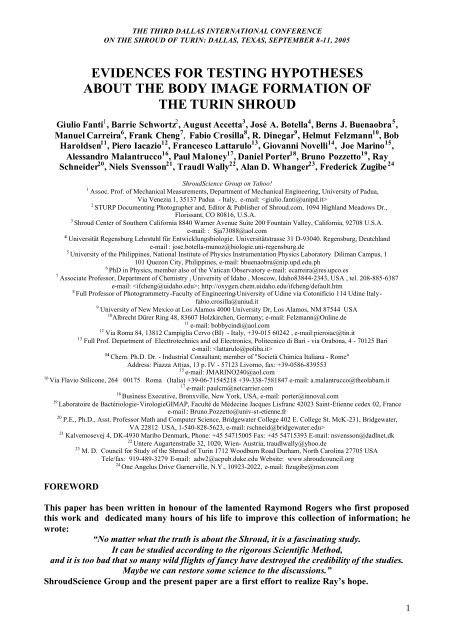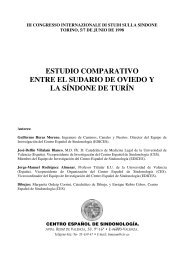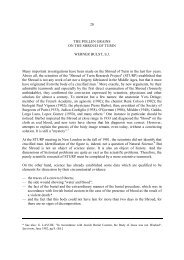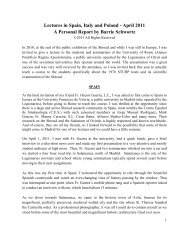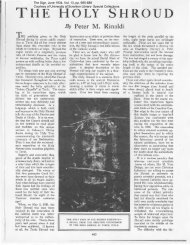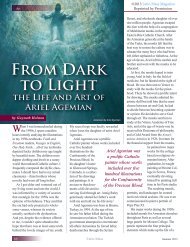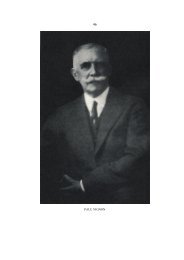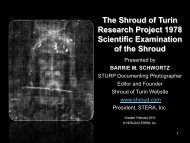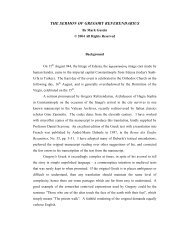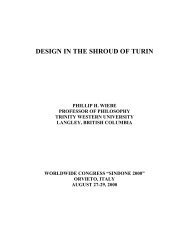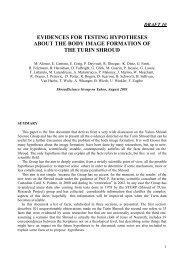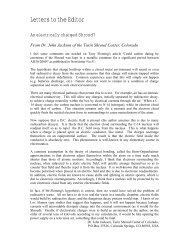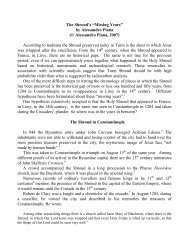Evidences for Testing Hypotheses about the Body Image Formation ...
Evidences for Testing Hypotheses about the Body Image Formation ...
Evidences for Testing Hypotheses about the Body Image Formation ...
Create successful ePaper yourself
Turn your PDF publications into a flip-book with our unique Google optimized e-Paper software.
THE THIRD DALLAS INTERNATIONAL CONFERENCEON THE SHROUD OF TURIN: DALLAS, TEXAS, SEPTEMBER 8-11, 2005A61) The blood on <strong>the</strong> TS is not denatured. There<strong>for</strong>e both <strong>the</strong> image-<strong>for</strong>mation mechanism and<strong>the</strong> 1532 fire did not involve processes that would denature <strong>the</strong> blood (Rogers 2004).A62) The blood from <strong>the</strong> large flow on <strong>the</strong> back darkened (scorched) at an adjoining scorch (Rogers1978).A63) The red flecks McCrone (1980, 2000) claimed were hematite had an organic matrix (Heller 1983,Rogers 2004).A64) Microscopic observation of blood flecks of sample 3EB showed specular reflection: <strong>the</strong>blood went onto <strong>the</strong> surface as a liquid (Rogers 1978).A65) Blood spots are much more visible on <strong>the</strong> TS by transmitted light than by reflected light;this implies that <strong>the</strong> blood saturated <strong>the</strong> cloth and it is not a superficial image as <strong>the</strong> body imager is(Rogers 1978).A66) Many blood traces visible on <strong>the</strong> frontal image are also visible on <strong>the</strong> back image in <strong>the</strong>same position (Fanti 2003).A67) Blood stains are well marked on <strong>the</strong> reverse side, although <strong>the</strong>y are fainter than on <strong>the</strong> frontside of TS (Fanti 2003, Whanger 2004).A68) Some human blood stains appear on and outside of <strong>the</strong> body image (left elbow) (Heller 1980,1981, Baima Bollone 1981, 1982, Jackson, 1987, Carreira, 1998).A69) In correspondence to <strong>the</strong> knees on <strong>the</strong> dorsal image, <strong>the</strong>re are scourge marks incorrespondence to lower luminance levels of <strong>the</strong> body image (Fanti 2003).A70) The blood on <strong>the</strong> TS does not fluoresce in ultraviolet illumination (no porphyria and nofluorescent pigments) (Rogers 1978).A71) The blood on <strong>the</strong> TS can be removed with a proteolytic enzyme (Adler 1999).A72) No smears are evident in <strong>the</strong> blood traces (Bucklin 1982, Ricci 1989, Antonacci 2000).A73) No potassium signals could be found in any of <strong>the</strong> blood area data (Morris 1980).A74) In UV fluorescence <strong>the</strong> scourge marks appear with dumbbell shapes (Bucklin 1982, Ricci 1989).A75) In UV fluorescence <strong>the</strong> scourges are resolved into fine scratches: three, and in some casesfour, parallel scratches can be distinguished (Bucklin 1982, Ricci 1989).A76) The blood stain corresponding to <strong>the</strong> right side of <strong>the</strong> chest 6th ribs shows separation ofblood from a clearer liquid material (Bucklin 1982).A77) The DNA found in blood spots is badly degraded. (Rogers 2005).A78) No broken fibers were found under <strong>the</strong> blood clots (N. Svensson 2005).2.1e) OTHERA79) Earthy material (limestone composed of aragonite with strontium and iron) was found on<strong>the</strong> feet of TS Man (Kohlbeck 1986, Nitowski 1986, 1998, Antonacci 2000). Earthy material was also found incorrespondence with <strong>the</strong> nose and <strong>the</strong> left knee (Pellicori 1981).A80) Drops of wax were found (Maloney 1989).A81) Microscopic observation of <strong>the</strong> bridge of <strong>the</strong> nose showed discontinuous distribution of lightgold-colored fibers. All were on <strong>the</strong> top of <strong>the</strong> yarn (Rogers 1978, 2004).A82) There is no observed microscopic, chemical, or spectroscopic evidence <strong>for</strong> <strong>the</strong> presence ofany dry powder responsible <strong>for</strong> <strong>the</strong> body image on <strong>the</strong> TS (Adler 1999).A83) Some little black spots (diameter of 1-2 mm) appear out of <strong>the</strong> body image (<strong>for</strong> example near<strong>the</strong> head, between <strong>the</strong> hair and <strong>the</strong> water stain); <strong>the</strong>y are also visible, in <strong>the</strong> same position, on <strong>the</strong>back surface of <strong>the</strong> TS (Maggiolo 2002/03, Fanti 2003, Rogers 2003).A84) Large water stains are visible on both sides of <strong>the</strong> cloth (Fanti 2004).A85) Silver traces were found around <strong>the</strong> burn holes in <strong>the</strong> scorch area of <strong>the</strong> TS (Heller 1983).A86) The white cloth used to cover <strong>the</strong> display board <strong>for</strong> <strong>the</strong> showing (1978) was fluorescent. RudyDichtel reported many intensely fluorescent short fibers on <strong>the</strong> surface of <strong>the</strong> Shroud (Rogers2004).A87) Aldehyde and carboxylic acid functional groups were detected in <strong>the</strong> TS fibers (Adler 1981).7
THE THIRD DALLAS INTERNATIONAL CONFERENCEON THE SHROUD OF TURIN: DALLAS, TEXAS, SEPTEMBER 8-11, 20052.2) Confirmed observationsType B refers to confirmed observations or conclusions based on a proof made in reference to <strong>the</strong>TS. There<strong>for</strong>e <strong>the</strong>se observations must also be used to test any new hypo<strong>the</strong>sis.2.2a) CHEMICAL-PHYSICAL CHARACTERISTIC OF THE LINEN YARNS AND FIBERSB1) The TS samples examined have herringbone 3:1 twill weave (Vial 1989).B2) Traditional dimensions of <strong>the</strong> TS of 436 x 110 cm (Baima Bollone 1978) are changed after 2002“restoration”: one side (<strong>the</strong> lower considering horizontal <strong>the</strong> body image, with <strong>the</strong> frontal side on<strong>the</strong> left) measured 437.7 cm in 2000 and 441.5 cm in 2002; <strong>the</strong> opposite side measured 434.5 in2000 and 442.5 in 2002; its height of 112.5 and 113 cm respectively on <strong>the</strong> left and on <strong>the</strong> right in2000 but 113.0 and 113.7 cm in 2002 (Ghiberti 2002). A measurement made in 1868 by Gastaldi(Baima Bollone 1978) reports <strong>the</strong> following dimensions: 410 x 140 cm (Scarpelli 1983).B3) The thickness of <strong>the</strong> cloth measured by Jackson with a micrometer is variable from 318 to 391micrometers (Rogers 2004).B4) There appears to be more variation in <strong>the</strong> diameter of warp yarns than weft Rogers (1978).B5) The TS weave is very tight (Raes 1974, Rogers 1978, Vial 1989).B6) Although yarns and design of Raes sample look like <strong>the</strong> main part of <strong>the</strong> cloth, linen fibersfrom <strong>the</strong> Raes sample that was cut in 1973 are chemically different (from reflected spectroscopyand chemical analysis) (Adler 2000, Rogers 2002).B7) Cotton fibers were found in <strong>the</strong> Raes samples and <strong>the</strong>y were identified as Gossypiumherbaceum, a common Middle East variety (Raes 1974, 1991).B8) The sewing connecting <strong>the</strong> upper linen band of <strong>the</strong> TS is very particular and typical of veryold manufacture (Flury Lemberg 2000, 2001).B9) Reflectance spectra, chemical tests, laser-microprobe Raman spectra, pyrolysis massspectrometry, and x-ray fluorescence all show that <strong>the</strong> image is not painted with any of <strong>the</strong>expected, historically-documented pigments (Schwalbe 1982; Morris 1980; Heller 1981, Mottern 1979).B10) Chemical tests showed that <strong>the</strong>re is no protein painting medium or protein-containingcoating in image areas (Rogers 1978-1981; Heller 1981; Pellicori 1980, 1981; Gilbert 1980; Accetta 1980; Miller 1981).B11) The image fibers do not show any sign of capillary flow of a colored or reactive liquid (Evans1978; Pellicori 1981).B12) Flakes of image color can be seen in o<strong>the</strong>r places where <strong>the</strong>y fell off and stuck to <strong>the</strong> adhesive.The chemical properties of <strong>the</strong> coatings are <strong>the</strong> same as <strong>the</strong> image color on image fibers. All of<strong>the</strong> color is on <strong>the</strong> surfaces of <strong>the</strong> fibers (Rogers 2002; Heller 1981).B13) There are no pigments on <strong>the</strong> body image in a sufficient quantity to explain <strong>the</strong> presence of animage (Pellicori 1981).2.2b) OPTICAL CHARACTERISTICS OF THE CLOTHB14) The TS linen has a lustrous finish (Rogers, 1978-1981).B15) If a fiber is colored, it is uni<strong>for</strong>mly colored around its cylindrical surface (Adler 1996, 1999);relatively long fibers show variation in color from non-image to image area (Fanti 2004).B16) Crease below <strong>the</strong> chin of <strong>the</strong> image: on <strong>the</strong> frontal surface of <strong>the</strong> TS, <strong>the</strong> inside part of creasehas a lighter color similar to <strong>the</strong> background, but it has darker margins similar to <strong>the</strong> image-color.On <strong>the</strong> back of <strong>the</strong> cloth, <strong>the</strong> same crease is darker in correspondence of <strong>the</strong> lighter color of <strong>the</strong>frontal surface and <strong>the</strong> margins are confused with <strong>the</strong> background: <strong>the</strong> darker margins are of <strong>the</strong>same straw-yellow color of <strong>the</strong> body image (Rogers 2004).B17) In <strong>the</strong> ultraviolet emission and absorption photographs <strong>the</strong> background cloth shows a lightgreenish yellow emission (Adler 2002).B18) Where one of <strong>the</strong> image-yarn crosses over ano<strong>the</strong>r, <strong>the</strong>re is often no color on <strong>the</strong> lower one(Heller 1983, Rogers 2005).8
THE THIRD DALLAS INTERNATIONAL CONFERENCEON THE SHROUD OF TURIN: DALLAS, TEXAS, SEPTEMBER 8-11, 2005B19) The image of <strong>the</strong> dorsal side of <strong>the</strong> body shows fairly <strong>the</strong> same color density and distributionas <strong>the</strong> ventral (Jumper 1984).B20) IR photograph of <strong>the</strong> face made by Judica Cordiglia, if compared with visible photographs of<strong>the</strong> face indicates <strong>the</strong> low absorption near <strong>the</strong> IR of <strong>the</strong> products of image <strong>for</strong>mation (JudicaCordiglia 1974, Accetta 1980, Rogers 2003).2.2c) BODY IMAGEB21) Up to now, all <strong>the</strong> attempts to reproduce a copy of <strong>the</strong> TS similar in all <strong>the</strong> detectedcharacteristics has failed (Carreira 1998, Fanti 2004).B22) The most of <strong>the</strong> prominent parts in <strong>the</strong> vertical direction (nose, beard, sole, calf) of <strong>the</strong> bodyimage are marked (Fanti 2003).B23) The hair on <strong>the</strong> front image is soft and not matted as would be expected if it were soaked witha liquid (Fanti 2004).B24) When <strong>the</strong>ir lengths are measured, <strong>the</strong> dorsal image is longer than <strong>the</strong> ventral image in amanner similar to <strong>the</strong> imprint on a sheet of a man having <strong>the</strong> head tilted <strong>for</strong>wards, his kneesslightly bent, and his feet extended (Craig 2003; Cagnazzo 1997-98; Fanti 2000).B25) The frontal body image (195 cm long) is compatible, within an uncertainty of +/-2 cm, with<strong>the</strong> dorsal image (202 m long) if it is supposed that <strong>the</strong> TS enveloped a corpse having <strong>the</strong> headtilted <strong>for</strong>ward, <strong>the</strong> knees partially bent and <strong>the</strong> feet stretched <strong>for</strong>wards and downwards (Basso 2000).B26) Based on cloth measurements (Baima Bollone 1978), <strong>the</strong> image corresponds to a man 175+/-2 cmtall (Simionato 1998-99; Faraon 1998-1999; Basso 2000).B27) The body image has <strong>the</strong> normal tones of light and dark reversed with respect to aphotograph, such that parts nearer to <strong>the</strong> cloth are darker (Jumper 1984, Craig 2004, Schneider 2004).B28) The luminance distribution of both <strong>the</strong> frontal and dorsal images has been correlated to <strong>the</strong>clearances between a three-dimensional surface of <strong>the</strong> body and a covering cloth (Quidor 1913,Sullivan 1973, Gastineau 1974, Jackson 1977, 1982, 1984, Fanti 2001, Moran 2002).B29) The luminance distribution of <strong>the</strong> body image can be correlated with a highly directionalmapping function (Jackson 1977, 1982, 1984).B30) The body image shows non-directional light sources in <strong>the</strong> sense that <strong>the</strong>re are no shadows,cast shadows, highlights, and reflected lights in or on <strong>the</strong> body image (Moran 2002; Craig 2003).B31) The absence of saturation implies that <strong>the</strong> image <strong>for</strong>mation did not “go to completion”, i.e.it did not produce <strong>the</strong> maximum number of conjugated carbon-carbon double bonds (Rogers 2003,Gilbert a1980: fig. 8 and 10).B32) In correspondence of image sections of cylindrical elements such as legs, <strong>the</strong> luminancelevels variation approximates a sinusoidal law (Fanti 2004).B33) In reference to a cloth wrapping a body, <strong>the</strong>re is no evidence of body image <strong>for</strong>mation at <strong>the</strong>sides of <strong>the</strong> body on both <strong>the</strong> frontal and dorsal TS images (Adler 1999; Moran 2002).B34) The Fourier trans<strong>for</strong>m of <strong>the</strong> body image shows a nearly continuous spectrum incorrespondence to <strong>the</strong> spatial frequencies up to 100 [1/m] (Fanti 1999; Maggiolo 2002/03).B35) The body image indicates <strong>the</strong> absence of brush strokes (Lorre 1977).B36) The frontal image, at least in correspondence to <strong>the</strong> head, is doubly superficial (Fanti andMaggiolo 2004).B37) The fingers in <strong>the</strong> image appear to be longer than average <strong>for</strong> a man, but <strong>the</strong>y are still within<strong>the</strong> normal range (Gaussian distribution) (Heller 1983, Whanger 2005).B38) <strong>Image</strong> distortions of hands, calves and torso on <strong>the</strong> TS of are very close to those obtained bya man enveloped on a sheet (Ercoline 1982; Simionato 1998/99; Fanti and Faraon 2000; Fanti 2001).B39) The very high rigidity of <strong>the</strong> body is evident on <strong>the</strong> back image especially in correspondenceof <strong>the</strong> buttocks: <strong>the</strong> anatomical contours of <strong>the</strong> back image demonstrate minimal surface flattening(Bucklin 1982; Basso 2000).B40) The image of <strong>the</strong> TS Man, shows <strong>the</strong> effects (wounds) of many pointed objects (Bucklin 1982,Ricci 1989).B41) The tibio-femural anthropometric index of <strong>the</strong> image of <strong>the</strong> TS Man is 83% (Fanti 1999).B42) No broken bones are evident on <strong>the</strong> body image (Bucklin 1982, Ricci 1989).9
THE THIRD DALLAS INTERNATIONAL CONFERENCEON THE SHROUD OF TURIN: DALLAS, TEXAS, SEPTEMBER 8-11, 2005B43) There is a swelling on <strong>the</strong> face over <strong>the</strong> right cheek (Bucklin 1982).B44) There is a slight deviation of <strong>the</strong> nose and at <strong>the</strong> tip of <strong>the</strong> nose is an area of discoloration(Bucklin 1982).B45) A body image is visible in areas of body-sheet non-contact zones, such as those betweennose and cheek (Fanti 2004).2.2d) BLOOD AND BODY FLUIDSB46) There is a first type of blood stain that corresponds to <strong>the</strong> blood exudated from clottedwounds and transferred to <strong>the</strong> cloth by being in contact with a wounded human body such asscourging and crown of thorns wounds or wrists wounds (Adler 1999).B47) There is a second type of blood stain that corresponds to <strong>the</strong> blood that directly flowed on <strong>the</strong>TS such as feet wounds or side wound with blood separation in a dense and a serous portion(Brillante 2002, Schneider 2004).B48) The UV photographs of single blood stains show a distinct serum clot retraction ring (Adler1999).B49) The chemical and physical parameters of <strong>the</strong> blood stains are different than mineralcompositions proposed by artists (Adler 1999).B50) The bloodstains observable on <strong>the</strong> back surface have been described as "imbibed flows "throughout <strong>the</strong> cloth (Ghiberti 2002).B51) Blood traces on <strong>the</strong> back surface of <strong>the</strong> TS are smaller in size when compared with <strong>the</strong>corresponding traces on <strong>the</strong> frontal side, showing that blood was transposed onto <strong>the</strong> clothtouching <strong>the</strong> frontal side of <strong>the</strong> TS (Fanti 2003).B52) The maintenance of <strong>the</strong> red bright color of <strong>the</strong> TS blood with time was observed, but <strong>the</strong>explanation of why <strong>the</strong> color is so red is not definitive (Brillante 2002).B53) There are blood traces not consistent with scalp hair traces soaked with blood incorrespondence to <strong>the</strong> image of <strong>the</strong> hair on <strong>the</strong> front side (Lavoie 1983, Fanti 1999).B54) The wrist wound position can be referred to as <strong>the</strong> hand nail used <strong>for</strong> <strong>the</strong> crucifixion (Fanti andMarinelli 2003).B55) The blood clots were transposed to <strong>the</strong> linen fabric during fibrinolysis (Brillante 1983; Lavoie 1983).The process of fibrinolysis could cause clots to liquefy sufficiently <strong>for</strong> <strong>the</strong> blood to transfer to <strong>the</strong>cloth as a serous-laden liquid ra<strong>the</strong>r than a moist jelly-like substance (Craig 2004).B56) Some blood stains are comparable to transfers that would be expected if <strong>the</strong> arms were posedin non horizontal position (Lavoie 1983, 2003, Fanti 2005, Schwortz 2005).2.2e) OTHERB57) The limestone found on <strong>the</strong> feet contains calcium in <strong>the</strong> <strong>for</strong>m of aragonite. Similarcharacteristics were found on samples coming from Ecole Biblique tomb in Jerusalem (Levi-Setti1985, Antonacci 2000).B58) It is unknown whe<strong>the</strong>r Saponaria officinalis can be detected on <strong>the</strong> Shroud (Rogers 2003; Jumper1984 ; Gilbert 1980).B59) Rust stains due to thumb tacks were found on <strong>the</strong> sides of <strong>the</strong> TS (Faraon 1998/99, Schwortz 2003).B60) Characteristics of <strong>the</strong> TS face and right foot are close to those found on some Byzantinecoins (gold-solidus) of <strong>the</strong> VII-XIII century A.D. (Moroni 1986).B61) Some water stains are older than <strong>the</strong> 1532 fire because <strong>the</strong>y indicate a different folding of<strong>the</strong> TS (Guerreschi and Salcito 2002).2.3) <strong>Evidences</strong> to be confirmedSeeing things and not seeing things, is perhaps <strong>the</strong> biggest problem in legitimate Shroud research."I think I see" and "I don't see" seems to be <strong>the</strong> underpinning of many “scientific” analyses. Thebody image on <strong>the</strong> Shroud was <strong>for</strong>med by some process. We don't know, <strong>for</strong> now, what that was,10
THE THIRD DALLAS INTERNATIONAL CONFERENCEON THE SHROUD OF TURIN: DALLAS, TEXAS, SEPTEMBER 8-11, 2005nor <strong>the</strong> shape of <strong>the</strong> cloth, nor <strong>the</strong> environment where <strong>the</strong> body was positioned: we can onlysuppose what that might have been; we don't know many variables.Our brain-eyes system may plays tricks on <strong>the</strong> researcher. Because of a priori assumptions, it maybe that he perceives things that con<strong>for</strong>m to something searched <strong>for</strong> and conversely, he may fail toperceive images because of not knowing what various objects look like. Many of <strong>the</strong> images arebelow ordinary human perceptual threshold, <strong>the</strong>re<strong>for</strong>e anything must be probed <strong>for</strong> documentablefacts, including using image enhancement techniques.Type C refers to facts that were evidenced by some researchers but that are not universallyaccepted; <strong>the</strong>re<strong>for</strong>e <strong>the</strong>y can help in <strong>for</strong>mulating new hypo<strong>the</strong>ses, <strong>the</strong>y can not be used to test a newhypo<strong>the</strong>sis.2.3a) BODY IMAGEC1) The chiaroscuro effect is caused by a different number of yellowed fibers per unit of surface, sothat this is an image with ‘areal’ density (Moran 2002, Fanti and Marinelli 2003).C2) <strong>Body</strong> image characteristics can be referred to <strong>the</strong> hypo<strong>the</strong>sized effect of a man becamemechanically transparent that radiated a burst of energy (Jackson 1977, 1984, 1990).C3) The TS face shows a sad but majestic serenity (Moroni 1997).2.3b) OTHERC4) Pollen grains relative to <strong>the</strong> zones of Palestine, Edessa, Constantinople and Europe werefound (Frei 1979, 1983; Danin 1999).C5) Pollen grains with incrustations soluble in water were found from <strong>the</strong> vacuumed samplestaken from <strong>the</strong> back surface of <strong>the</strong> cloth (Riggi 2003).C6) The wrapped or enveloped body was a corpse (Bucklin 1982, Lavoie 1983, Jackson 1998, Petrosillo 1988,Brillante 2002, Baima Bollone 2000, Fanti 2003, Zugibe 2005), but someone still states that <strong>the</strong> body was in a stateof coma (Bonte 1992, Hoare 1994, Gruber 1998, Kuhnke 2004, Felzmann 2005).C7) The human blood is of AB group (Baima Bollone 1981, 1982).C8) The radiocarbon dating of 1988 states that <strong>the</strong> TS linen has an age of 1260-1390 (Damon et al.1989).C9) “Preliminary estimates of <strong>the</strong> kinetics constants <strong>for</strong> <strong>the</strong> loss of vanillin from lignin indicate amuch older age <strong>for</strong> <strong>the</strong> cloth than <strong>the</strong> radiocarbon analyses” (Rogers 2005).C10) There is <strong>the</strong> image of an identified coin (dilepton lituus) on <strong>the</strong> right eye (Filas 1982; Haralick 1983;Barbesino 1997).C11) There is an image of ano<strong>the</strong>r identifiable coin (Pilate lepton simpulum) over <strong>the</strong> left eye(Balossino 1997; Barbesino 1997).C12) The TS is like a funerary sheet (Persili 1998).C13) There are some analogies between <strong>the</strong> TS and <strong>the</strong> Oviedo Sudarium, including manycongruent blood stains (Whanger 1996)".C14) There are various writings around <strong>the</strong> Face (Marion 1998).C15) There are many identified floral images on <strong>the</strong> TS, which indicate that <strong>the</strong> Shroud originatedin <strong>the</strong> vicinity of Jerusalem in <strong>the</strong> spring of <strong>the</strong> year, and which have <strong>the</strong> appearance expected fromcorona discharge. Some images are consistent with <strong>the</strong> fruits of pistacia plants, which were used asburial spices (Danin, 1999; Whanger, 2000).C16) Human DNA comes from Riggi’s blood samples from <strong>the</strong> TS, this because three genesegments were cloned and studied (Garza Valdes 2001).C17) Results from <strong>the</strong> DNA analysis, made from <strong>the</strong> TS blood at <strong>the</strong> University of Texas,S.Antonio, U.S.A., indicate that some genetic characteristics are relative to <strong>the</strong> Semitic race (<strong>for</strong>example hair) (Riggi 2003).C18) The TS Man died because of an infarct followed by hemopericardium (Malantrucco 1992).C19) Some teeth are visible on <strong>the</strong> image (Whanger 2000, Accetta 2001).C20) The skull is visible on <strong>the</strong> TS (Whanger 2000).11
THE THIRD DALLAS INTERNATIONAL CONFERENCEON THE SHROUD OF TURIN: DALLAS, TEXAS, SEPTEMBER 8-11, 2005C21) <strong>Image</strong>s of <strong>the</strong> bones of <strong>the</strong> fingers, of <strong>the</strong> palms (metacarpals) and of <strong>the</strong> wrist are visible, andin particular a hidden thumb (Whanger 2000, Accetta 2001).C22) A sponge is visible on <strong>the</strong> TS (Whanger 2000).C24) A large nail with two crossed smaller nails are visible on <strong>the</strong> TS (Whanger 2000).C25) A shaft and head of spear are visible on <strong>the</strong> TS (Whanger 2000).C26) A crown of thorns with stalks and flowers is visible on <strong>the</strong> TS (Whanger 2000).C27) Some bloodstains such as those on <strong>the</strong> arms and <strong>the</strong> “reverse-3” on <strong>the</strong> <strong>for</strong>ehead present adiscontinuity in which a more attenuate region is evident (Jackson 1987, Schneider 2004).C28) Several wood tubules were found from an oak from Riggi’s samples (Garza Valdes 2001).C29) A bioplastic coating was found around <strong>the</strong> TS linen fibers (Garza Valdes 2001).C30) Traces of saliva are visible on <strong>the</strong> image (Scheuermann 1983).C31) Traces of tears may be visible on <strong>the</strong> body image under <strong>the</strong> right eye (Guerreschi 2000).C32) An ecchymosis, on <strong>the</strong> left shoulder-blade level, and a wound on <strong>the</strong> right shoulder that addedto <strong>the</strong> wounds of <strong>the</strong> scourge are evident; in such areas <strong>the</strong> wounds caused by <strong>the</strong> scourge appearenlarged probably by <strong>the</strong> pressure of <strong>the</strong> patibulum (Ricci 1989).C33) Some early paintings of Jesus (be<strong>for</strong>e <strong>the</strong> VI century A.D. ) in Rome have been producedindependently from <strong>the</strong> TS but have a significant similarity to <strong>the</strong> image on <strong>the</strong> TS. If it isassumed that <strong>the</strong>se paintings go back to people, who have known Jesus personally and knew<strong>the</strong>re<strong>for</strong>e, how he has looked like. The significant similarities to <strong>the</strong> image on <strong>the</strong> TS indicates thatboth types of images go back to <strong>the</strong> same source: <strong>the</strong> historical Jesus (Felzmann 2003-2005).C34) Natron (sodium carbonate) was found in <strong>the</strong> dusts aspired from <strong>the</strong> back surface of <strong>the</strong> TS(Riggi 1982).C35) Aloe and myrrh were found by microscopic analysis (Baima Bollone 1983 and Nitowski 1986) but not byHeller (1983) and Rogers 2003).C36) The scourge marks are part of <strong>the</strong> image and primarily not caused from blood coming outof <strong>the</strong> wounds (Hoare 1994).C37) A ponytail is visible on <strong>the</strong> back image (Fanti and Marinelli 2001, fig. 12 B and C, Antonacci 2000, fig 3).C38) In <strong>the</strong> image of <strong>the</strong> back of <strong>the</strong> head some blood stains are partially masked (Scheuermann1984).C39) Some blood stains are comparable to transfers that would be expected if a person was posed in<strong>the</strong> vertical position (Lavoie 1983, 2003).2.3) Analogies between <strong>the</strong> TS Man and Christ, from <strong>the</strong> Old and <strong>the</strong> New TestamentIt is hypo<strong>the</strong>sized by many researchers that <strong>the</strong> TS is <strong>the</strong> burial cloth of Jesus of Nazareth. Thefollowing list presents passages in <strong>the</strong> Scriptures that have an impact on <strong>the</strong> TS. If <strong>the</strong>se Scripturesare accepted as an historic document, Type D facts can be useful to verify <strong>the</strong> proposed hypo<strong>the</strong>ses.D1) “And no sign shall be given to it except <strong>the</strong> sign of <strong>the</strong> prophet Jonah.” (Mat 16:4). “And all fleshshall see <strong>the</strong> salvation of God.” (Luk 3:6). “And I am with you always, even to <strong>the</strong> end of <strong>the</strong> age ”(Mat 28:20). The TS shows a sign promised by Jesus: like Jonah “who remained <strong>for</strong> three days in <strong>the</strong>stomach of <strong>the</strong> big fish”, <strong>the</strong> Man of <strong>the</strong> TS remained <strong>for</strong> three days inside <strong>the</strong> sepulcher (Rodante1987).D2) “A woman came to him with an alabaster jar of very expensive perfume, which she poured onhis head as he was reclining at <strong>the</strong> table.” (Mat 26:7); “When she poured this perfume on my body,she did it to prepare me <strong>for</strong> burial.” (Mat 26:12). Less than 48 hours be<strong>for</strong>e his crucifixion, <strong>the</strong> hair ofJesus was anointed with a very valuable oil and this fact must be considered <strong>for</strong> an hypo<strong>the</strong>sis<strong>about</strong> <strong>the</strong> TS image <strong>for</strong>mation (Scheuermann 1984).D3) “Then Pilate took Jesus and scourged Him.” (Joh 19:1). “I offered my back to those who beat Me,/my cheeks to those who pulled out my beard; /I did not hide my face /from mocking and spitting”(Isa 50:6). The whole body of <strong>the</strong> MTS is cruelly scourged, except <strong>for</strong> <strong>the</strong> breast where, hitting, one12
THE THIRD DALLAS INTERNATIONAL CONFERENCEON THE SHROUD OF TURIN: DALLAS, TEXAS, SEPTEMBER 8-11, 2005could cause death. The scourging was given like punishment apart, more abundant (120 strokes)than <strong>the</strong> normal (39 strokes) as a prelude to crucifixion (Zaninotto 1984).D4) “Then <strong>the</strong>y struck Him on <strong>the</strong> head with a reed and spat on Him” (Mar 15:19). “And <strong>the</strong>y struckHim with <strong>the</strong>ir hands” (Joh 19:3). The TS Man was hit on his face: <strong>for</strong> instance various tumefactionsand <strong>the</strong> breakage of <strong>the</strong> nasal septum are evident (Fanti and Marinelli 1998).D5) “And <strong>the</strong> soldiers twisted a crown of thorns and put it on His head” (Joh 19:2). “When <strong>the</strong>y hadtwisted a crown of thorns, <strong>the</strong>y put it on His head” (Mat 27:29 etc). The TS Man was crowned withthorns. The head presents many wounds caused by sharp bodies (Fanti and Marinelli 1998).D6) “And He, bearing His cross, went out to… (<strong>the</strong>) Golgotha” (Joh 19:17). The TS Man presents on<strong>the</strong> shoulders excoriations imputable to <strong>the</strong> transport of <strong>the</strong> horizontal part of <strong>the</strong> cross (patibulum)(Ricci 1989).D7) “Now as <strong>the</strong>y came out, <strong>the</strong>y found a man of Cyrene, Simon by name. Him <strong>the</strong>y compelled tobear His cross” (Mat 27:32). The TS Man fell repeatedly to <strong>the</strong> ground; this is demonstrated by <strong>the</strong>dust particles on <strong>the</strong> nose and on <strong>the</strong> left knee. Likely he was helped in <strong>the</strong> transport of <strong>the</strong> cross(Fanti and Marinelli 1998).D8) “My throat is dry” (Psa 69:3), “And <strong>for</strong> my thirst <strong>the</strong>y gave me vinegar to drink” (Psa 69:21). From<strong>the</strong> <strong>for</strong>ensic medicine analysis it results that <strong>the</strong> MTS died dehydrated (Intrigillo 1998).D9) “Where (on <strong>the</strong> Golgotha) <strong>the</strong>y crucified Him” (Joh 19:17). “They pierced My hands and Myfeet. I can count all My bones” (Psa 22:16-17) “You have taken by lawless hands, have crucified, andput to death” (Act 2:23). The TS Man too was crucified (Fanti and Marinelli 1998).D10) “Reproach has broken my heart” (Psa 69,20). "And Jesus cried out again with a loud voice,and yielded up His spirit” (Mat 27:50) “Because <strong>for</strong> Your sake I have borne reproach; Shame hascovered my face” (Psa 69:8). “My heart is like wax; It has melted within Me” (Psa 22:14). Thehemopericardium, diagnosed to <strong>the</strong> TS Man like consequence of <strong>the</strong> infarct, causes a violentdilatation of <strong>the</strong> pericardic pleura with consequent shooting pain from <strong>the</strong> back breast-bone andimmediate death (Malantrucco 1992).D11) "And saw that He was already dead, <strong>the</strong>y did not break His legs" (Joh 19:33).”Nor shall youbreak one of its bones” (Exo 12,46). Contrary to many Roman crucifixions, <strong>the</strong>y didn’t break <strong>the</strong> TSMan legs (Fanti and Marinelli 1998).D12) “But one of <strong>the</strong> soldiers pierced His side with a spear” (Joh 19:34), “But He was wounded <strong>for</strong>our transgressions” (Isa 53,5). “<strong>the</strong>n <strong>the</strong>y will look on Me whom <strong>the</strong>y pierced” (Zec 12:10). The TSMan too was pierced in <strong>the</strong> side after his death (Zaninotto 1989).D13) “And immediately blood and water came out” (Joh 19:34). “Flowing from under <strong>the</strong> thresholdof <strong>the</strong> temple toward <strong>the</strong> east, <strong>for</strong> <strong>the</strong> front of <strong>the</strong> temple faced east” (Eze 47:1). “This is He whocame by water and blood Jesus Christ; not only by water, but by water and blood” (1Joh 5:6). TheTS Man also presents a blood and serum flow (Malantrucco 1992).D14) “And Nicodemus, who at first came to Jesus by night, also came, bringing a mixture ofmyrrh and aloes, <strong>about</strong> a hundred pounds” (Joh 19:39). “Then <strong>the</strong>y took <strong>the</strong> body of Jesus, andbound it in strips of linen with <strong>the</strong> spices, as <strong>the</strong> custom of <strong>the</strong> Jews is to bury” (Joh 19:40). Someresearchers state that <strong>the</strong> TS body was buried with aromatics such as aloe and myrrh because <strong>the</strong>yfound <strong>the</strong>ir traces on <strong>the</strong> cloth (Baima Bollone 1983).D15) “When Joseph had taken <strong>the</strong> body, he wrapped it in a clean linen cloth (or shroud), and laidit in his new tomb” (Mat 27:59-60). The TS Man too was enveloped or wrapped in a new andexpensive sheet, bought by a wealthy person (Fanti and Marinelli 1998).D16)“Nor will You allow Your Holy One to see corruption” (Act 2:27). “For You will not leave mysoul in Sheol, Nor will You allow Your Holy One to see corruption” (Psa 16:10). The TS doesn’tshow signs of putrefaction (Fanti and Marinelli 1998).D17) “You shall let none of it (<strong>the</strong> Lamb) remain until morning, and what remains of it untilmorning you shall burn with fire. It is <strong>the</strong> Lord’s Passover” (Exo 12:10). Some researcher states that<strong>the</strong> TS presents a double sign: <strong>the</strong> disappearance and <strong>the</strong> burning, if one refers to <strong>the</strong> radianthypo<strong>the</strong>sis (Rinaudo 1998).13
REFERENCESTHE THIRD DALLAS INTERNATIONAL CONFERENCEON THE SHROUD OF TURIN: DALLAS, TEXAS, SEPTEMBER 8-11, 20051. ACCETTA A.: “Nuclear Radiation and <strong>the</strong> Shroud: Head <strong>Image</strong>”, Dallas International Conference on <strong>the</strong> Shroud of Turin,Dallas, Texas, U.S.A., 25-28 October 2001.2. ACCETTA J. S. and BAUMGART J. S., "Infrared reflectance spectroscopy and <strong>the</strong>rmographic investigations of <strong>the</strong>Shroud of Turin," Applied Optics 19, 1921-1929 (1980).3. ADLER A. D.: “The origin and nature of blood on <strong>the</strong> Turin Shroud”, in: “Turin Shroud – <strong>Image</strong> of Christ?” Proceedingsof <strong>the</strong> Symposium of Hong Kong, 3-9 March 1986, Cosmos Printing Press Ltd., Hong Kong, March 1987, pp. 57-59.4. ADLER A. D.: “Updating Recent Studies on <strong>the</strong> Shroud of Turin”, ACS Symp. Ser. no. 625, Archaeological Chemistry:Organic, Inorganic, and Biochemical Analysis, Mary Virginia Orna Editor, Am. Chem. Soc., ch. 17, pp. 223-228, 1996.5. ADLER A.: “The nature of <strong>the</strong> <strong>Body</strong> <strong>Image</strong> on <strong>the</strong> Shroud of Turin”, 1999, http://www.shroud.com/pdfs/adler.pdf6. ADLER, A. D., “The Shroud fabric and <strong>the</strong> body image: chemical and physical characteristics”, in: “The Turin Shroud,past, present and future”, Proceedings of <strong>the</strong> International Scientific Symposium, Torino, 2-5 March 2000, Effatà Editrice,Cantalupa (TO) 2000, pp. 51-73.7. ADLER A. D., "Fur<strong>the</strong>r Spectroscopic Investigations of Samples of <strong>the</strong> Shroud of Turin, Proceedings of <strong>the</strong> 1998 DallasShroud Symposium, Michael Minor, ed., Dallas 2000. Also published in "The Orphaned Manuscript," A Shroud SpectrumInternational Special Issue, Dorothy Crispino, ed.8. ADLER A. D., “Chemical and Physical aspects of <strong>the</strong> Sindonic images” in “The Orphaned Manuscript” Dorothy Crispino,ed., Effatà Editrice, Torino Italy, 2002, pg 11-25.9. ALLEN N. P.L., “The Turin Shroud and <strong>the</strong> crystal lens”, Empowerment Technologies Pty Ltd, Porth Elizabeth, SouthAfrica 1998.10. ANTONACCI M., “The Resurrection of <strong>the</strong> Shroud”, M. Evans and C. Inc., New York, USA, 2000.11. BAIMA BOLLONE P.L., Benedetto P.P.: Alla ricerca dell’Uomo della Sindone, Ed Mondatori, Milano 1978, p.48.12. BAIMA BOLLONE P. L., JORIO M ., A. L. MASSARO: “La dimostrazione della presenza di tracce di sangue umano sullaSindone”, Sindon, Quaderno No. 30, Dicembre 1981, pp. 5-8.13. BAIMA BOLLONE P. L.i, JORIO M., A. L. MASSARO: “Identificazione del gruppo delle tracce di sangue umano sullaSindone”, Sindon, Quaderno No. 31, Dicembre 1982, pp. 5-9.14. BAIMA BOLLONE P. L., “La presenza della mirra, dell'aloe e del sangue sulla Sindone”, in: “La Sindone, Scienza eFede”, Atti del II Convegno Nazionale di Sindonologia, Bologna 1981, CLUEB, Bologna 1983, pp. 169-174.15. BAIMA BOLLONE P. L., “Sindone e scienza all’inizio del terzo millennio”, Editrice La Stampa, Torino 2000.16. BAIMA BOLLONE P. L., , MARINO C., PESCARMONA G.: “Il significato del colore delle macchie di sangue dellaSindone ed il problema della bilirubina”, Sindon Nuova Serie, Quaderno No. 15, Giugno 2001, pp. 19-29.17. BALOSSINO N., “L'immagine della Sindone, ricerca fotografica e in<strong>for</strong>matica”, Elle Di Ci, Leumann (TO) 1997.18. BARBESINO F., MORONI M., “L'ordalia del Carbonio 14”, Mimep-Docete, Pessano (MI) 1997.19. BARBET P.: “La prova della autenticità della Sindone nelle sue macchie di sangue”, Sindon, Quaderno No. 14-15,Dicembre 1970, pp. 21-43.20. BASSO R., BIANCHINI G., FANTI G.: “ Compatibilità fra immagine corporea digitalizzata e un manichino antropomorfocomputerizzato ” Congresso Mondiale “Sindone 2000”, Orvieto, 27-29 Agosto 2000http://www.iro.umontreal.ca/~latendre/art1.pdf.21. BENFORD, MS., MARINO. J. “Textile Evidence Supports Skewed Radiocarbon Date of Shroud of Turin”, 2002,http://shroud.com/pdfs/textevid.pdf22. BENFORD, MS., MARINO. J., special contribution by Robert Buden, President, Tapestries and Treasures. “HistoricalSupport of a 16 th Century Restoration in <strong>the</strong> Shroud C-14 Sample Area”, 2002, http://shroud.com/pdfs/histsupt.pdf23. BONTE, W., in HERBST, K. "Kriminalfall Golgatha", Deutscher Bücherbund, 199224. BORTOLUZZI D. degree <strong>the</strong>sis tutored by G. Fanti, academic year 2001-2002, Dipartimento di Ingegneria Meccanica,Padua University, Italy.25. BRILLANTE Carlo: “La fibrinolisi nella genesi delle impronte sindoniche”, in: “La Sindone, Scienza e Fede”, Atti del IIConvegno Nazionale di Sindonologia, Bologna 27-29 Novembre 1981, CLUEB, Bologna 1983, pp. 239-241.26. BRILLANTE C., FANTI G., MARINELLI E., “Bloodstains characteristics to be considered in laboratory reconstruction of<strong>the</strong> Turin Shroud”, IV Symposium Scientifique International sur le Linceul de Turin, Paris, 25-26 April 2002.27. BROWN J. Shroud Science Group communication 2004.28. BRUNATI E. Shroud Science Group communication 2003.29. BUCKLIN R.: The Shroud of Turin: Viewpoint of a Forensic Pathologist, Shroud Spectrum International, N.S., Dec 1982and Legal Medicine annual, W.B. Sauders, Philadelphia, July 1982.30. CAGNAZZO A., “Analisi antropometrica della Sindone di Torino mediante sistemi di visione”, Degree <strong>the</strong>sis, tutor G.Fanti, Dipartimento di Ingegneria Meccanica, Università di Padova, Academic Year 1997/98.31. CARREIRA Manuel M., La Sábana Santa desde el punto de vista de la física, in: AA. VV. – La Síndone de Turín –Estudios y aportaciones – Cento Español de Sindonología, Valencia 1998, pp. 141-172.32. CHAMBERLAIN T. C., "The Method of Multiple Working <strong>Hypo<strong>the</strong>ses</strong>," Journal of Geology, 5(8), 837-848 (1987).33. CRAIG E. A., BRESEE R. R.: “ <strong>Image</strong> <strong>Formation</strong> and <strong>the</strong> Shroud of Turin”, Journal of Imaging Science and Technology,Volume 38, No. 1, pp. 59-67, 1994.34. CRAIG E.: Shroud Science Group communication 2003; 2004.35. CURTO S. La S. Sindone, ricerche e studi della commissione d’esperti nominata dall’Arcivescovo di Torino Card. MichelePellegrino, nel 1969, Supplemento alla rivista diocesana Torinese, gennaio 1976, pp 59-8536. DANIN A., WHANGER A. D., BARUCH U., WHANGER M., “Flora of <strong>the</strong> Shroud of Turin”, Missouri Botanical GardenPress, 1999, pp. 1-52.37. DAMON P.E., DONAHUE D.J., GORE B.H., HATHEWAY A.L., JULL A.J.T., LINICK T.W., SERCEL P.J., TOOLINL.J., BRONK C.R., HALL E.T., HEDGES R.E.M., HOUSLEY R., LAW I.A., PERRY C., BONANI G., TRUMBORE S.,15
THE THIRD DALLAS INTERNATIONAL CONFERENCEON THE SHROUD OF TURIN: DALLAS, TEXAS, SEPTEMBER 8-11, 2005WÖLFLI W., AMBERS J.C., BOWMAN S.G.E., LEESE M.N., TITE M.S., “Radiocarbon dating of <strong>the</strong> Shroud of Turin”,Nature, Vol. 337, February 16, 1989, pp. 611-615. http://www.shroud.com/nature.htm38. DE CECCO M. FANTI G., Study <strong>for</strong> a Vision System <strong>for</strong> <strong>the</strong> Colorimetric Mapping of <strong>the</strong> Turin Shroud, III Int. CongressStudies on <strong>the</strong> Turin Shroud, Turin, Italy, 1998, http://www.shroud.com/fanti4en.pdf.39. DE LISO G.: "Verifica sperimentale della <strong>for</strong>mazione di immagini su teli di lino trattati con aloe e mirra in concomitanzadi terremoti", "Sindon Nuova Serie", Quad. n. 14, dicembre 2000, pp. 125-13040. DE LISO G.: “Verifica Sperimentale della Formazione di Immagini su Teli Trattati con Aloe e Mirra in Concomitanza diSismi”, IV Int. Scientific Symposium on <strong>the</strong> Turin Shroud, Paris, 25-26 April 2002.41. DE SALVO J. A., “The image <strong>for</strong>mation process of <strong>the</strong> Shroud of Turin and its similarities to Volckringer patterns”,Sindon n. 31, dicembre 1982, pp. 43-50.42. EVANS Mark collection of photomicrographs archived by Barrie Schwortz, especially ME-29, 197843. ERCOLINE, W.R., DOWNS R.C. Jr., JACKSON J.P., “Examination of <strong>the</strong> Turin Shroud <strong>for</strong> image distortions”, IEEE1982 Proceedings of <strong>the</strong> International Conference on Cybernetics and Society, October 1982, pp. 576-579.44. FANTI G., MARINELLI E.: “Results of a Probabilistic Model Applied to <strong>the</strong> Research carried out on <strong>the</strong> Turin Shroud”,III Int. Congress Studies on <strong>the</strong> Turin Shroud, Turin, Italy, 1998, http://www.shroud.com/fanti3en.pdf.45. FANTI G., MARINELLI E.: “Cento prove sulla Sindone: un giudizio probabilistico sull’autenticità”, Ed. Messaggero,Padova, Italy 1999.46. FANTI G., MARINELLI E.: “ A study of <strong>the</strong> front and back body enveloping based on 3D in<strong>for</strong>mation”, DallasInternational Conference on <strong>the</strong> Shroud of Turin, Dallas, Texas, U.S.A., 25-28 October 200147. G. Fanti, M. Moroni: “Comparison of Luminance Between Face of Turin Shroud Man and Experimental Results”, Journalof Imaging Science and Technology, 2002, vol. 46-2, pp. 142-154, March/April 2002, Internet:http://www.imaging.org/store/epub.cfm?abstrid=812548. FANTI G.: “A review of 3d characteristics of <strong>the</strong> Turin Shroud body image” Worksohop Italy-Canada on 3D DigitalImaging and Modeling Applications of heritage, industry, medicine & land, Padova, April 3-4 2001.49. FANTI G., FARAON S., “Pulizia e ricostruzione computerizzata dell’immagine corporea dell’Uomo della Sindone”, in:Atti del Congresso Mondiale Sindone 2000, Orvieto 27-28 agosto 2000, Gerni Editori, San Severo (FG) 2002, vol. I pp.25-31 e vol. III pp.11-18.50. FANTI G., Shroud Science Group communication 2003; 2004, 2005.51. FANTI G., MARINELLI: “La Sindone Rinnovata – misteri e certezze”, Progetto Editoriale Mariano, Vigodarzere, Padova,Italy 2003.52. FANTI G., MAGGIOLO R.: The double superficiality of <strong>the</strong> frontal image of <strong>the</strong> Turin Shroud, accepted <strong>for</strong> publication inJournal of Optics A: Pure and Applied Optics as a paper, 12 March 2004.53. FANTI G., “Resolution of images obtained without a camera using MTF curves”, Shroud Science Group communication2004.54. FANTI G., - Fanti G: “Valutazione della risoluzione di immagini mediante analisi del modulo della funzione ditrasferimento”, accepted <strong>for</strong> Congresso di Misure Meccaniche e Termiche, Brescia, Settembre 2005.55. FANTI G., LATTARULO F., SCHEUERMANN O.: <strong>Body</strong> <strong>Image</strong> <strong>Formation</strong> Hypo<strong>the</strong>sis Based on Corona Discharge,Third Dallas International Conference on <strong>the</strong> Shroud of Turin: Dallas, Texas, September 8-11, 2005.56. Fanti G., Lattarulo F., Scheuermann O.: <strong>Body</strong> <strong>Image</strong> <strong>Formation</strong> <strong>Hypo<strong>the</strong>ses</strong> Based On Corona Discharge, The ThirdDallas International Conference on <strong>the</strong> Shroud of Turin, Dallas, Texas, September 8-11, 2005.57. FARAON S., Tecniche di elaborazione numerica per la ricostruzione tridimensionale dell’immagine corporea contenutanella Sindone di Torino, Tesi di laurea, relatore G. Fanti, Dipartimento di Ingegneria Meccanica, Università di Padova,Anno Accademico 1998/99.58. FELLER, R L., _Accelerated aging : photochemical and <strong>the</strong>rmal aspects_, The J. Paul Getty Trust, 1994, 292 pages59. FEIGL, F. and ANGER, V., 1966, Spot Tests in Organic Analysis, Elsevier Pub. Co., New York.60. FELZMANN H., Shroud Science Group communication 2003-200561. FELZMANN H., "Müssen Christen anders glauben", Triga 2005.62. FILAS F., The Dating of <strong>the</strong> Shroud of Turin from coins of Pontius Pilate, Cogan, Youngtown, Arizona, USA, 1982.63. FLURY LEMBERG M: “Die leinwand des Turiner Grabtuches zum technischen befund”, in: “The Turin Shroud. Past,present and future”, Proceedings of <strong>the</strong> International Scientific Symposium of Turin, 2-5 March 2000, Effatà Ed.,Cantalupa (TO) 2000, pp. 21-43.64. FLURY LEMBERG M.: “Un tessuto di preziosità incalcolabile”, in: ZACCONE G. M. (Ed.), “Le due facce della Sindone,pellegrini e scienziati alla ricerca di un volto”, Ed. ODPF, Torino 2001, pp. 137-142.65. FLURY LEMBERG M., “Sindone 2002 Preservation", ed. ODPF, Torino 2003.66. FORD D.: “The Shroud of Turin’s ‘blood’ images: blood, or paint? A history of science inquiry”, 2000,http://www.shroud.com/pdfs/<strong>for</strong>d1.pdf67. FREI M., “Il passato della Sindone alla luce della palinologia”, in: “La Sindone e la Scienza”, Atti del II CongressoInternazionale di Sindonologia, Torino 1978, Edizioni Paoline, Torino 1979, pp. 191-200.68. FREI M., “Identificazione e classificazione dei nuovi pollini della Sindone”, in: “La Sindone, Scienza e Fede”, Atti del IIConvegno Nazionale di Sindonologia, Bologna 1981, CLUEB, Bologna 1983, pp. 277-284.69. GASTINEAU P. 1974, http://perso.wanadoo.fr/gira.cadouarn/english/faq_english/tridimensionality.htm.70. GARZA-VALDES L., “The DNA of God?”, Berkley Books, New York, 2001.71. GHIBERTI G., “Sindone le immagini 2002 Shroud images”, ODPF, Torino 2002.72. GILBERT R. Jr. and GILBERT M,. "Ultraviolet-visible reflectance and fluorescence spectra of <strong>the</strong> Shroud of Turin,"Applied Optics 19, 1930-1936 (1980).73. GLICK G. , Shroud Science Group communication 2003.74. GROBSTEIN P., BUTOI B., Lateral Inhibition Simulator http://serendip.brynmawr.edu/bb/latinhib_app.html, 1997.75. GRUBER E.R, KERSTEN H., "Jesus starb nicht am Kreuz - Die Botschaft des Turiner Grabtuchs", Langen Müller,Munich 199816
THE THIRD DALLAS INTERNATIONAL CONFERENCEON THE SHROUD OF TURIN: DALLAS, TEXAS, SEPTEMBER 8-11, 200576. GUERRESCHI A: “New Elements Revealed from Photograph <strong>about</strong> two Details: <strong>the</strong> Wound in The Wrist and <strong>the</strong> RightEye”, Worldwide Congress “Sindone 2000”, Orvieto, 27-29 Agosto 2000.77. GUERRESCHI A. and SALCITO M.: Ricerche fotografiche e in<strong>for</strong>matiche sulle bruciature e sugli aloni visibili sullaSindone e conseguenze sul piano storico, 4th International Scientific Symposium, Centre International d’Études sur leLinceul de Turin, Paris, April 25-26, 2002.78. HAROLDSEN B., , Shroud Science Group communication 2003.79. HARALICK, R.M., "Analysis of Digital <strong>Image</strong>s of <strong>the</strong> Shroud of Turin," Virginia Polytechnic Institute, Blacksburg, VA1983.80. HELLER J. H. and ADLER A. D.,: “Blood on <strong>the</strong> Shroud of Turin”, Applied Optics, Vol. 19, No. 16, August 15, 1980, pp.2742-2744.81. HELLER J. H. and ADLER A. D., "A Chemical Investigation of <strong>the</strong> Shroud of Turin," Canadian Society of ForensicScience Journal 14 (1981), pp.81-103.82. HELLER J. H.: “Report on <strong>the</strong> Shroud of Turin”, Houghton Mifflin C., Boston 1983, p. 144.83. HOARE R., "The Turin shroud is genuine", Souvenir Press, London 199484. IACAZIO, P. - La qualità del microcontrollo tessile della Santa Sindone, International Congress <strong>for</strong> <strong>the</strong> Study of <strong>the</strong>Shroud of Turin"Science and <strong>the</strong> Shroud" June 5 through 7, Turin, Italy, 1998.85. IACAZIO, P., Shroud Science Group communication 2004.86. INTRIGILLO G., Sindone, l’istruttoria del secolo, Edizioni San Paolo, Cinisello Balsamo (Milano) 1998, p. 76.87. ISO-GUM, Guide to <strong>the</strong> expression of Uncertainty in Measurement (International Organization <strong>for</strong> Standardization,Geneva, Switzerland, 1993), http://physics.nist.gov/cuu/Uncertainty/isoorder.html.88. JACKSON J. P. JUMPER E.J., MOTTERN B. , STEVENSON E.: The Three Dimensional <strong>Image</strong> on Jesus’ Burial Cloth,E.J., “Proceedings of <strong>the</strong> 1977 United States Conference of research on <strong>the</strong> Shroud of Turin”, Albuquerque 1977, HolyShroud Guild, New York 1977.89. JACKSON J.P., JUMPER E.J., ERCOLINE W.R., “Three dimensional characteristic of <strong>the</strong> Shroud <strong>Image</strong>”, IEEE 1982Proceedings of <strong>the</strong> International Conference on Cybernetics and Society, October 1982, pp. 559-575.90. JACKSON J.P., JUMPER E.J., ERCOLINE W.R., “Correlation of image intensity on <strong>the</strong> Turin Shroud with <strong>the</strong> 3-Dstructure of a human body shape” - Applied Optics, Vol. 23, No. 14, July 15, 1984, pp. 2244-2270.91. JACKSON J.: The Vertical Alignment of <strong>the</strong> Frontal <strong>Image</strong>, Shroud Spectrum International No. 32/33,1989;92. JACKSON J.: "Blood and Possible <strong>Image</strong>s of Blood on <strong>the</strong> Shroud" Shroud Spectrum International No. 24, Sept. 1987;93. JACKSON John P.: “Is <strong>the</strong> image on <strong>the</strong> Shroud due to a process hereto<strong>for</strong>e unknown to modern science?”, ShroudSpectrum International No. 34, March 1990, pp. 3-29.94. JACKSON J. P., Does <strong>the</strong> Shroud of Turin show us <strong>the</strong> Resurrection?, Biblia y Fe, 199895. JUDICA CORDIGLIA G., “L'Uomo della Sindone è il Gesù dei Vangeli?”, Ed. Fondazione Pelizza, Chiari, BS, Italy, 197496. JUDICA CORDIGLIA G. B: La Sindone immagine elettrostatica? in: “La Sindone, nuovi studi e ricerche”, Atti del IIICongresso Nazionale di Studi sulla Sindone, Trani 1984, Edizioni Paoline, Cinisello Balsamo (MI) 1986, pp. 314-325.97. JUDICA CORDIGLIA G. B: IR photography furnished to G. Fanti in 2001.98. JUMPER E. J., ADLER A. D., JACKSON J. P., PELLICORI S. F., HELLER J. H., and DRUZIK J. R., "A comprehensiveexamination of <strong>the</strong> various stains and images on <strong>the</strong> Shroud of Turin," ACS Advances in Chemistry, ArchaeologicalChemistry III:205, 447-476 (1984).99. KUHNKE, G, "Rom und das Grabtuch", Tenea 2004.100. KERLIN J.: http://childrensermons.com/shroud/present.htm.101. KOHLBECK J. A., NITOWSKI E. L., “New evidence may explain image on Shroud of Turin”, Biblical ArchaeologyReview, vol. 12, n. 4, luglio-agosto 1986, pp.23-24.102. LATTARULO F.: L'immagine sindonica spiegata attraverso un processo sismoelettrico, III Congresso internazionale distudi sulla Sindone, Torino, 5-7 Giugno 1998.103. LATTARULO F.: Shroud Science Group communication 2003 and private communication to G. Fanti 2003.104. LAVOIE G. R., LAVOIE B. B., DONOVAN V. J., BALLAS J. S., “Blood on <strong>the</strong> Shroud of Turin: Part I, ShroudSpectrum International n. 7, giugno 1983, pp. 15-20.105. LAVOIE G. R., LAVOIE B. B., DONOVAN V. J., BALLAS J. S.: “Blood on <strong>the</strong> Shroud of Turin: Part II – Theimportance of time in <strong>the</strong> transfer of blood clots to cloth as distinctive clot images”, Shroud Spectrum International, No. 8,September 1983, pp. 2-10.106. LAVOIE G., Resurrected, Texas: Thomas More, 2000.107. LAVOIE G., Shroud Science Group communication 2003.108. LEVI-SETTI R.,CROW C., WANG Y. L.: “Progress in H>igh Resolution scannino Ion microscopi and Secondary IonMass Spectrometry Imaging Microanalysis”, Scanning Electron Microscopy 2, 1985; 535-552109. LINDNER E., “The Shroud of Jesus Christ: <strong>the</strong> ‘Scientific Gospel’ to renew <strong>the</strong> faith in Resurrection”, in: Atti delCongresso Mondiale Sindone 2000, Orvieto 27-28 agosto 2000, Gerni Editori, San Severo (FG) 2002, vol. I pp. 165-173 evol. III pp. 55-58.110. LORRE J. J. - Lynn D. J., Digital enhancement of images of <strong>the</strong> Shroud of Turin, in: Proceedings of <strong>the</strong> 1977 United StatesConference of research on <strong>the</strong> Shroud of Turin, Albuquerque 1977, Holy Shroud Guild, New York 1977.111. MAGGIOLO R.: Procedure eidomatiche anche basate sulla tras<strong>for</strong>mata spaziale di Fourier per il miglioramento delleimmagini: applicazione alla Sindone di Torino, Tesi di laurea, relatore G. Fanti, Dipartimento di Ingegneria Meccanica,Università di Padova, Anno Accademico 2002/03.112. MALANTRUCCO L., “L'equivoco Sindone”, LDC, Leumann, Torino, Italy, 1992.113. MALONEY, P. C., “The current status of pollen research and prospects <strong>for</strong> <strong>the</strong> future”, Relazione al SymposiumScientifique International de Paris sur le Linceul de Turin, 7-8 Septembre 1989.114. MALONEY, P. C., Shroud Science Group communication 2004.115. MARINO, J., BENFORD MS. “Evidence <strong>for</strong> <strong>the</strong> Skewing of <strong>the</strong> C-14 Dating of <strong>the</strong> Shroud of Turin Due to Repairs”,2000, http://shroud.com/pdfs/marben.pdf.17
THE THIRD DALLAS INTERNATIONAL CONFERENCEON THE SHROUD OF TURIN: DALLAS, TEXAS, SEPTEMBER 8-11, 2005116. MARION A. , COURAGE A. L., La Sacra Sindone, Neri Pozza, Vicenza, Italy, 1998.117. MARION A. "Discovery of Inscriptions on <strong>the</strong> Shroud of Turin, “Digital <strong>Image</strong> Processing", Optical Engineering, vol. 37,pgs. 2308-2313, 1998.118. MCCRONE W. C. and SKIRIUS C., "Light Microscopical Study of <strong>the</strong> Turin 'Shroud,' I," Microscope 28, 105 (1980).119. MCCRONE W. C.: “Light microscopical study of <strong>the</strong> Turin ‘Shroud’ II”, The Microscope 28, No. 4, 1980, pp. 115-120;120. MCCRONE W. C.: “Light microscopical study of <strong>the</strong> Turin ‘Shroud’ III”, The Microscope 29, No. 1, 1981, pp. 19-39.121. MCCRONE W. C.: “Shroud image is <strong>the</strong> work of an artist”, The Skeptical Inquirer 6, No. 3, 1982, pp. 35-36;122. MCCRONE W. C.: “The Shroud of Turin: blood or artist's pigment?”, Accounts of Chemical Research, AmericanChemical Society, 23, 1990, pp. 77-83;123. MCCRONE W. C.: “Shroud 1999”, The Microscope 47, No. 1, 1999, pp. 55-61;124. MCCRONE W. C.: “The Shroud <strong>Image</strong>”, The Microscope 48, No. 2, 2000, pp. 79-85.125. MEACHAM, W., “The au<strong>the</strong>ntication of <strong>the</strong> Turin Shroud: An Issue in Archaeological Epistemology”, CurrentAnthropology, Vol. 24, No. 3, June 1983, pp. 283-311. http://www.shroud.com/meacham2.htm126. MILLER V. D. and PELLICORI S. F., "Ultraviolet fluorescence photography of <strong>the</strong> Shroud of Turin," Journal ofBiological Photography 49, 71-85 (1981).]127. MILLER V. D. Personal communication to R. Rogers, 14 June 2003.128. MORAN K., FANTI G.: “Does <strong>the</strong> Shroud body image show any physical evidence of Resurrection?”, 4th InternationalScientific Symposium, Centre International d’Études sur le Linceul de Turin, Paris, April 25-26, 2002.129. MORONI M., “Teoria numismatica dell'itinerario sindonico”, in: “La Sindone, nuovi studi e ricerche”, Atti del IIICongresso Nazionale di Studi sulla Sindone, Trani 1984, Edizioni Paoline, Cinisello Balsamo (MI) 1986, pp. 103-124.130. MORONI M., BARBESINO F., “Apologia di un falsario”, Maurizio Minchella Editore, Milano 1997.131. MORRIS R. A., SCHWALBE L. A., and LONDON J. R., "X-Ray Fluorescence Investigation of <strong>the</strong>132. Shroud of Turin," X-Ray Spectrometry 9, 40-47 (1980).133. MOTTERN R. W., LONDON R. J., and MORRIS R. A., "Radiographic Examination of <strong>the</strong> Shroud of Turin - aPreliminary Report," Materials Evaluation 38, 39-44 (1979).134. MUNGAI C., “Analisi della correlazione fra luminanza e distanza di immagini aventi caratteristiche di tridimensionalità”,Degree <strong>the</strong>sis, tutor G. Fanti, Dipartimento di Ingegneria Meccanica, Università di Padova, academic yera 2001/2002.135. NEAL R. Shroud Science Group communication 2004.136. NICKELL J.: “Inquest on <strong>the</strong> Shroud of Turin”, New Updated Ed., 1997.137. NIST web site, http://physics.nist.gov/PhysRefData/Star/Text/contents.html.138. NIST -Uncertainty:http://physics.nist.gov/cuu/Uncertainty/glossary.html;http://physics.nist.gov/cuu/Uncertainty/basic.html.139. NITOWSKI E.,”The field and Laboratory Report of <strong>the</strong> Environmental Study of <strong>the</strong> Shroud in Jerusalem, CarmentileMonastery, Salt Lake City, Utah, USA, 1986.140. NITOWSKI E., “Through <strong>the</strong> Microscope”, Ariel Museum, Salt Lake City 1998.141. PASTORE F. , La struttura tessile della Sindone, in: La Sindone, indagini scientifiche - Atti del IV Congresso Nazionale diStudi sulla Sindone, Siracusa 1987 - Ed.Paoline, Cinisello Balsamo -MI 1988, pp. 64-73.142. PESCE DELFINO V.: “E l'uomo creò la sindone”, II Ed. Dedalo, Bari 2000.143. PELLICORI S. F., "Spectral properties of <strong>the</strong> Shroud of Turin," Applied Optics, 19 (1980), pp. 1913-1920.144. PELLICORI S. F. and EVANS M. S., "The Shroud of Turin Through <strong>the</strong> Microscope," Archaeology, January/February 35-43 (1981).145. PERSILI A., Sulle tracce del Cristo Risorto, Ed. Casa della Stampa, Tivoli Italy, 1988.146. PETROSILLO O, MARINELLI E., La Sindone, storia di un enigma, Rizzoli, Milano 1998, p. 267.147. PICKNETT L., PRINCE C., “Turin Shroud”, Harper Collins, New York, USA 1994.148. PORTER D.: Shroud Science Group communication 2003; 2004.149. QUIDOR G. 1913, http://perso.wanadoo.fr/gira.cadouarn/english/faq_english/tridimensionality.htm.150. G. RAES "The textile study of 1973-1974", published by Curto S. in La S. Sindone, Rivista Diocesana Torinese, 79-83,1974.151. G. RAES Shroud Spectrum International n°38/30, 1991.152. RICCI G., “L'Uomo della Sindone è Gesù, diamo le prove”, Ed. Carroccio, Vigodarzere (PD) 1989.153. RIGGI G., Rapporto Sindone 1978-1982, Il Piccolo Ed., Torino 1982.154. RIGGI G., verbal communication to G. Fanti 2003.155. RINAUDO J. B.: “<strong>Image</strong> <strong>for</strong>mation on <strong>the</strong> Shroud of Turin explained by a protonic model affecting radiocarbon dating”,III Congresso internazionale di studi sulla Sindone, Torino, 5-7 Giugno 1998.156. RODANTE S., Le realtà della Sindone, Massimo, Milano 1987.157. ROGERS, R. N., SMITH, L. C., "Application of Combined Pyrolysis – TLC to <strong>the</strong> Study of Chemical Kinetics," J.Chromatog. 48, 268 (1970).158. ROGERS R. "Proceedings of <strong>the</strong> 1977 United States Conference of research on <strong>the</strong> Shroud of Turin", Albuquerque 1977,Holy Shroud Guild, New York 1977159. ROGERS R. Research Notebood: Shroud, October 1978.160. ROGERS R, Research Notebook: Shroud, 1978-1981.161. ROGERS R, personal communication, 1981.162. ROGERS R.. “Scientific method applied to <strong>the</strong> Shroud of Turin, a review”, http://shroud.com/pdfs/rogers2.pdf, 2002163. ROGERS R. Shroud Science Group communication 2003, 2004.164. ROGERS R.: Studies on <strong>the</strong> radiocarbon sample from <strong>the</strong> Shroud of Turin. Thermochimica Acta, Vol. 425, Issues 1-2 , 20Jan. 2005, pp. 189-194.165. SCARPELLI N. : Analisi dele de<strong>for</strong>mazionidel tessuto della S. Sindone in ”, in: “La Sindone, Scienza e Fede”, Atti del IIConvegno Nazionale di Sindonologia, Bologna 1981, CLUEB, Bologna 1983, pp. 337-344.166. SCHNEIDER. Shroud Science Group communication 2004.18
THE THIRD DALLAS INTERNATIONAL CONFERENCEON THE SHROUD OF TURIN: DALLAS, TEXAS, SEPTEMBER 8-11, 2005167. SCHWALBE L. A. and R. N. ROGERS, "Physics and Chemistry of <strong>the</strong> Shroud of Turin, a Summary of <strong>the</strong> 1978Investigations," Analytica Chimica Acta 135 (1982), pp.3-49.168. SCHEUERMANN O.: “Hypo<strong>the</strong>sis: Electron emission or absorption as <strong>the</strong> mechanism that created <strong>the</strong> image on <strong>the</strong>Shroud of Turin – Proof by experiment” first edition September 1983, Fondazione 3M, Segrate, Milano, Italy 2003.169. SCHEUERMANN O.: “Appendix I to Hypo<strong>the</strong>sis: Electron emission or absorption as <strong>the</strong> mechanism that created <strong>the</strong>image on <strong>the</strong> Shroud of Turin – Proof by experiment”, Sept. 1984, private communication to G. Fanti170. SCHEUERMANN O.:”Das Tuch”, Verlag Friedrich Pustet, Regensburg, Deutschland, 1987.171. SCHWARZ Gün<strong>the</strong>r: “der Menschensohn” – Aramaistische Untersuchungen zu den synoptischen MenschensohnwortenJesu: Beiträge zu Weisssenschaft vom Alten und Neuen Testament, 1986, Kohlhammer Verlag, Stuttgart/Berlin/Köln.172. SCHNEIDER R. Shroud Science Group communication 2004, 2005.173. SCHWORTZ B., Shroud Science Group communication 2003, 2004, 2005.174. SIMIONATO A., “Caratteristiche tridimensionali dell’Uomo della Sindone: analisi cinematica con manichino numerico econfronti sperimentali”, Tesi di laurea, relatore G. Fanti, Dipartimento di Ingegneria Meccanica, Università di Padova,Anno Accademico 1998/99.175. SULLIVAN B., “The Shroud of Turin:Report of preliminary studies”National Review, July 20, 1973.176. SVENSSON N. Shroud Science Group communication 2005.177. UPINSKY A.A., June 1993, Paris Conference.178. UPINSKY A. A., “L’énigme du Linceul, la prophétie de l’an 2000”, Fayard, Paris 1998.179. VAN HAELST R., Radiocarbon Dating <strong>the</strong> Turin Shroud, http://www.shroud.com/vanhels3.htm, 1997.180. VIAL G., in "Étude Technique du Linceul de Turin, in Actes du 1er Symposium International de Paris, CIELT 1989.181. VIGNON P., “Le Saint-Suaire de Turin devant la Science, l'Archeologie, l'Histoire, l'Iconographie, la Logique”, Masson etC. Editeurs, Paris 1902.182. VOLCKRINGER J., “The Holy Shroud: science confronts <strong>the</strong> imprints”, The Runciman Press, Manly, Australia 1991.183. WHANGER A. D., WHANGER M., “Polarized image overlay technique: a new image comparison method and itsapplications”, Applied Optics, Vol. 24, No. 6, March 15, 1985, pp. 766-772.184. WHANGER A. D., Shroud Science Group communication 2003-2005.185. WHANGER A. D., WHANGER M. W., A comparison of <strong>the</strong> Sudarium of Oviedo and <strong>the</strong> Shroud of Turin using <strong>the</strong>polarized image overlay technique, in: Sudario del Señor, Actas del I Congreso Internacional sobre El Sudario de Oviedo,Oviedo, 29-31 Octubre 1994 - Servicio de Publicaciones, Universidad de Oviedo 1996, pp. 379-381.186. WHANGER M. & A. "The Shroud of Turin, An Adventure of Discovery," Providence House Publishers, Franklin, TN1998.187. WHANGER A. D., Council <strong>for</strong> Study of <strong>the</strong> Shroud of Turin 2000, http://www.duke.edu/~adw2/shroud/188. WHANGER A. D., "Evidence <strong>for</strong> Radiation from <strong>the</strong> Shroud <strong>Image</strong> Itself in <strong>the</strong> <strong>Formation</strong> of <strong>the</strong> Shroud <strong>Image</strong>s,", in "TheTurin Shroud: Past, Present, and Future," Eds. Scannerini, S. and Savarino, P., Effata Editrice, Turin, Italy 2000.189. WOLFS F., Introduction to <strong>the</strong> Scientific Method, 2000,http://teacher.nsrl.rochester.edu/phy_labs/AppendixE/AppendixE.html.190. WILSON I., “The blood and <strong>the</strong> Shroud, new evidence that <strong>the</strong> world's most sacred relic is real”, The Free Press, NewYork 1998.191. WILSON N. http://www.shadowshroud.com/images.htm.192. ZANINOTTO G., Flagellazione romana, Centro Romano di Sindonologia, Roma 1984.193. ZANINOTTO G., Pier Angelo Gramaglia ovvero: il complesso del barbitonsore, Collegamento pro Sindone, settembreottobre1989, pp. 42-49.194. ZUGIBE and ROGERS collection of 86 photomicrographs, archived by Barrie Schwortz 1978, 1985.195. ZUGIBE F. Shroud Science Group communication 2003; 2004.196. ZUGIBE F., The Crucifiction of Jesus, a Forensic Inquiry, M. Evans & Co. New York 2005.19


